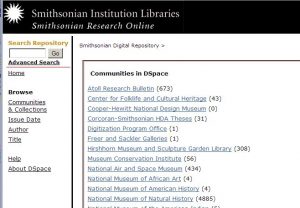
James Smithson bequeathed his fortune to the people of the United States with the clear impetus for the “increase and diffusion of knowledge.” The Smithsonian Libraries takes that message to heart by striving to connect ideas and information to you, and all whom we serve. Consider this an overview of Open Access (with capital O and A) and open access (lowercase o & a) here at the Libraries. Long story short: if you have access to the internet, you have access to an increasing number of quality, peer-reviewed journals and scholarly publications (as long as you know where to look).
Open Access can be best described as a movement among academics and researchers to provide the fruits of their intellectual endeavors openly and without the barriers of pay or time delay. While this movement towards intellectual sharing has a rich history throughout the centuries (public libraries, archives and museums being the vanguard), the Open Access movement as a specific historic idea became relevant only with the widespread adoption of the World Wide Web, and the possibility, for the first time, of a distribution network that didn’t rely on printing physical copies. Whether it be online access to scholarly research or the rights to reuse those results as needed, the Open Access movement has allowed products of research to be reached more broadly than ever before. Institutions around the world take advantage of the annual Open Access Week in October to promote open access. The Smithsonian Libraries, for instance, was proud to cohost a Wikipedia Edit-a-thon during this past October’s Open Access Week.
The Budapest Open Access Initiative was a turning point in open access. The December 2001 meeting codified the aims of the Open Access Movement into two complementary strategies: what is now referred to as the green strategy—placing articles in freely accessible repositories, and the gold strategy—publishing in open access journals to begin with.
The drivers of this change are many—and it definitely remains a contested space as political, social, and economic arguments both for and against open access continue to be passionately waged. But alas, dear reader, if you are looking for political intrigue, this is not the space for you. Instead, this post hopes to focus on how you can benefit from open access material, both by the Smithsonian and more broadly. (The Open Access Directory has a nice History of OA, for those interested).

Let’s start with the green strategy—the archiving of research publication products (articles, books, chapters, etc) in open repositories. The Smithsonian Libraries has been managing the official digital repository for the Smithsonian Institution for almost a decade. A component of Research Online, the Smithsonian Digital Repository is home to almost 18,000 articles, books, chapters, and other publications grouped into a number of communities. These communities can range from more traditional administrative units of the Smithsonian to pan-institutional initiatives and special projects. Content can be accessed directly through the Repository, as well as through the Research Bibliography component of Research Online, or through the Libraries’ catalog, SIRIS.
Beyond the Smithsonian, a couple great resources exist for finding similar repositories at other institutions: ROAR, the Registry of Open Access Repositories, and OpenDOAR, the Directory of Open Access Repositories. With these services, you can search content, search for specific repositories, browse by repository software (helpful for you fellow data managers with questions for others running digital repositories), and look at statistics about repositories. Another site comes from the Cybermetrics Lab, the largest public research body in Spain (the Consejo Superior de Investigaciones Cientificas, or CSIC). This one ranks repositories based on size, visibility, the richness of their files, and the number of papers. The Smithsonian Digital Repository is ranked 61st in the United States (261st world-wide), for those of you keeping score.
Along the lines of the green strategy, the Smithsonian has a number of other initiatives to bring research publications into broader access. The Biodiversity Heritage Library is a consortium of natural history and botanical libraries with more than 40 million pages of digitized biodiversity literature made available for open access and responsible use. The Libraries has also begun to digitize the public domain collections in our History, Art, And Culture library branches under the Cultural Heritage Library moniker. Both collections, along with most of our digitized content, can be found on the Internet Archive.
The gold strategy of open access begins with the research publication process from the start. Rather than make research available after publication, this strategy involves publishing in open access channels directly. This new model of publishing involves scholarly journals making available their content online without financial, legal, or technical barriers (other than access to the web). It is supported by funding through alternate means (either subsidies, payment by the author to publish, etc.), rather than through subscriptions and per-article fees that more traditional journals use. Many open access journals are as rigorously peer-reviewed as other journals, and require the same amount of sophistication in determining the authoritativeness of the content as any other journal. Yet the benefits of open access journals mean they are increasingly embraced by researchers. Journals such as PLoS ONE and those of BioMedCentral have made a name for themselves in relatively few years. The Directory of Open Access Journals (DOAJ) provides a categorized and searchable directory of scholarly journals, numbering well over 8,000. Keep in mind that open access can range from immediate free access to everything, access to only a portion of research articles within a journal, to access after a set time period (usually 6 months to a year). Akin to the DOAJ, there is a Directory of Open Access Books (DOAB), that provides a similar directory of academic peer-reviewed books.
Within the Smithsonian Libraries, we maintain a list of free journals as well as databases that can be accessed from any computer, (unlike the ones we subscribe to, where access is limited to computers at the Smithsonian). The hope is our curated list of open access ejournals and databases will complement the research interests of those we serve regularly, namely the researchers at the Smithsonian Institution. Also available are the Smithsonian Contributions and Studies Series, which provides a platform for research conducted either by Smithsonian researchers or using Smithsonian collections.
Mining the data within Research Online, we can even see the trend towards open access within the Institution itself. Below is a chart that documents the publication of articles in Open Access Journals by Smithsonian-affiliated researchers from 1990 to 2012. You can clearly see the growth of publishing in open access journals.
The Open Access movement is having profound impacts in the world of research, libraries, and publishing. As subscription costs rise and budgets get riskier, libraries like us are doing what we can to maintain access and stay ahead of the curve. Regardless of what the future holds, we are always working diligently to provide the best information available. Of course, this article does not even get into the topics of open data, creative commons, and open source software. But hopefully you’ll now be able to find out more using one of the sources mentioned above!


Be First to Comment